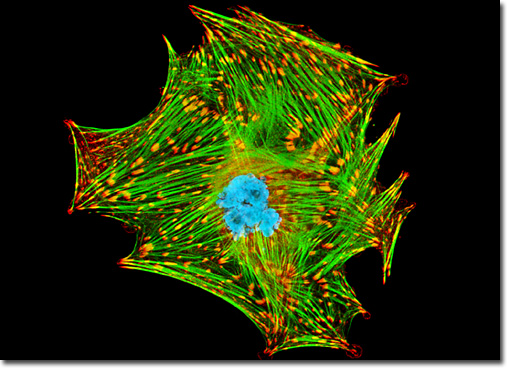Fluorescence Digital Image Gallery
Mink Uterus Endometrium Epithelial Cells (GMMe)
|
Vinculin is a protein 117 kiloDaltons in size that is associated with focal adhesion and adherens junctions, which are complexes that serve as nucleation sites for actin filaments and as crosslinkers between the external medium, plasma membrane, and actin cytoskeleton. The head region of vinculin contains the binding sites for the proteins talin and alpha-actinin, and its tail region, which is rod-like in shape, contains the binding sites for filamentous actin and paxillin. Investigations indicate that a proline-rich domain between the head and tail of vinculin interacts with vasodilator-stimulated phosphoprotein (VASP), a substrate of cyclic AMP-dependent or cyclic GMP-dependent kinases. Recent studies of vinculin suggest that the role the protein plays in cellular adhesion, motility, and intercellular communication varies depending upon alterations in the three-dimensional structure of the protein. For example, it has been demonstrated that by alternating between an active and inactive form, vinculin can regulate the mobility of cells, and may, therefore, be involved in wound healing, embryonic tissue development, and the metastasis of cancerous tumors. The culture of mink uterus endometrium cells illustrated above was immunofluorescently labeled with primary anti-vinculin mouse monoclonal antibodies followed by goat anti-mouse secondary antibodies (IgG) conjugated to Alexa Fluor 568 (red fluorescence emission). Note the prominent staining of the cellular attachment network in the central portion and periphery of these cells. In addition, the specimen was simultaneously stained for DNA with the ultraviolet-absorbing probe Hoechst 33342, and for the cytoskeletal filamentous actin network with Alexa Fluor 488 conjugated to phalloidin. Images were recorded in grayscale with a QImaging Retiga Fast-EXi camera system coupled to an Olympus BX-51 microscope equipped with bandpass emission fluorescence filter optical blocks provided by Omega Optical. During the processing stage, individual image channels were pseudocolored with RGB values corresponding to each of the fluorophore emission spectral profiles. |
© 1995-2025 by Michael W. Davidson and The Florida State University. All Rights Reserved. No images, graphics, software, scripts, or applets may be reproduced or used in any manner without permission from the copyright holders. Use of this website means you agree to all of the Legal Terms and Conditions set forth by the owners.
This website is maintained by our
|
